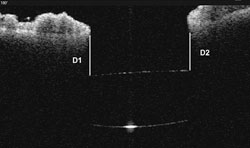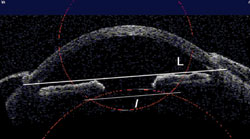Anterior segment OCT can be used to evaluate IOL tilt
OCT has an advantage over ultrasound biomicroscopy because it is noninvasive with a high resolution and uses less time.
 Amar Agarwal |
Accurate positioning of an IOL in the capsular bag is vital in preventing postoperative IOL tilt and astigmatism. IOL tilt is one of the components of malposition that invariably leads to pseudophakic astigmatism, loss of best corrected vision and change in wavefront aberrations. Ultrasound biomicroscopy, Scheimpflug images and anterior segment optical coherence tomography have been used in evaluation of IOL positioning. We have utilized anterior segment OCT for estimation of tilt in IOLs implanted within the capsular bag after uneventful phacoemulsification.
Study
In this observational case series, 123 eyes of 92 patients who had uneventful phacoemulsification with a posterior chamber IOL implanted in the capsular bag were included. The inclusion criteria were eyes with an in-the-bag fixated IOL after uneventful phacoemulsification, and the exclusion criteria were complicated cataract surgeries with posterior capsular rent or subsequent Nd:YAG capsulotomy. Cross-sectional imaging of the IOL was done with Visante anterior segment OCT (Carl Zeiss Meditec). Anterior segment single scan mode was used. Images were taken in four axes: 180°–0°, 225°–45°, 315°–135° and 270°–90°.
The images were then analyzed with the caliper tools in the OCT software for iris vault (D1, D2: Distance in mm between the iris margin and the anterior surface of the IOL) (Figure 1). Using MatLab version 7.1, the anterior segment single scan images were analyzed. A line (L) passing through the limbus on either side of the image was marked as the reference line (Figure 2). A second line (l) joining the long axis of the IOL (Figure 2) was marked. This was executed in all four quadrants in all the eyes. The slopes were calculated for both the straight lines (L, l).
 Figure 1. IOL position seen with corneal high-resolution OCT image. D1, D2: Distance in mm from iris margin to IOL edge. |
 Figure 2. Anterior segment OCT analysis of IOL position. L-slope of limbus, l- slope of IOL. Images: Agarwal A |
When the reference lines along the limbus and the IOL optic were parallel, the optic was considered as not tilted. The angle in degrees between the two lines (L, l) was determined. Corneal topography was obtained from Orbscan (Bausch + Lomb).
OCT for tilt analysis
OCT is a noninvasive, high-resolution imaging method that provides cross-sectional tomography of the ocular structures in vivo. It has many promising clinical applications in cataract and refractive surgery as well as in glaucoma diagnosis and anterior segment tumor imaging. Here we have described the application of IOL tilt examination with the aid of anterior segment OCT. IOL malposition is one of the indications for the removal, exchange or repositioning of a posterior chamber IOL (Figure 3). Even though there have been reports on examination of an IOL with OCT, there are no reports on the IOL tilt analysis. The high-speed OCT with 1,310 nm wavelength used in our study has an axial resolution of 18 µm and transverse resolution of 60 µm. It has a scan speed of about 8 frames/sec. With the anterior segment scan, a 16 mm × 6 mm image was obtained, and the corneal vertex, limbus and IOL were visualized. The corneal scan gives a high-resolution cross-sectional quantitative imaging of the IOL position.
|
|
The main advantage of OCT over ultrasound biomicroscopy is that it is noninvasive with a high resolution and uses less time. Hence, this can be performed in the early postoperative period and in traumatized corneas. Scheimpflug images taken from the Pentacam (Oculus) have also been used for tilt analysis. Purkinje reflections, photographic documentation and anterior segment analysis system were the other methods used for evaluation of IOL position.
The aim of the study was to identify the ability of the anterior segment OCT to detect IOL position in in-the-bag IOLs after an uneventful phacoemulsification. The same has been shown by deriving the slopes of the limbus and IOL. We have taken the limbus as the anatomical reference line because it can be delineated easily in the image and is easy for any observer. This can be done in eyes in the immediate postoperative period and in eyes with poor corneal clarity due to edema. The limitation is that pupillary dilatation is required for evaluation. In our study, it was noted that 180°–0° axis is the most suitable axis for good visualization of an IOL. However 360° IOL position was possible in 22.7% of the eyes.
Conclusion
This high-speed anterior segment OCT can be used in analysis of tilt and position in eyes with sulcus-fixated glued IOLs and sutured scleral-fixated IOLs as well.

- Amar Agarwal, MS, FRCS, FRCOphth, is director of Dr. Agarwal’s Eye Hospital and Eye Research Centre. Prof. Agarwal is the author of several books published by SLACK Incorporated, publisher of Ocular Surgery News, including Phaco Nightmares: Conquering Cataract Catastrophes, Bimanual Phaco: Mastering the Phakonit/MICS Technique, Dry Eye: A Practical Guide to Ocular Surface Disorders and Stem Cell Surgery and Presbyopia: A Surgical Textbook. He can be reached at 19 Cathedral Road, Chennai 600 086, India; fax: 91-44-28115871; e-mail: dragarwal@vsnl.com; website: www.dragarwal.com.

